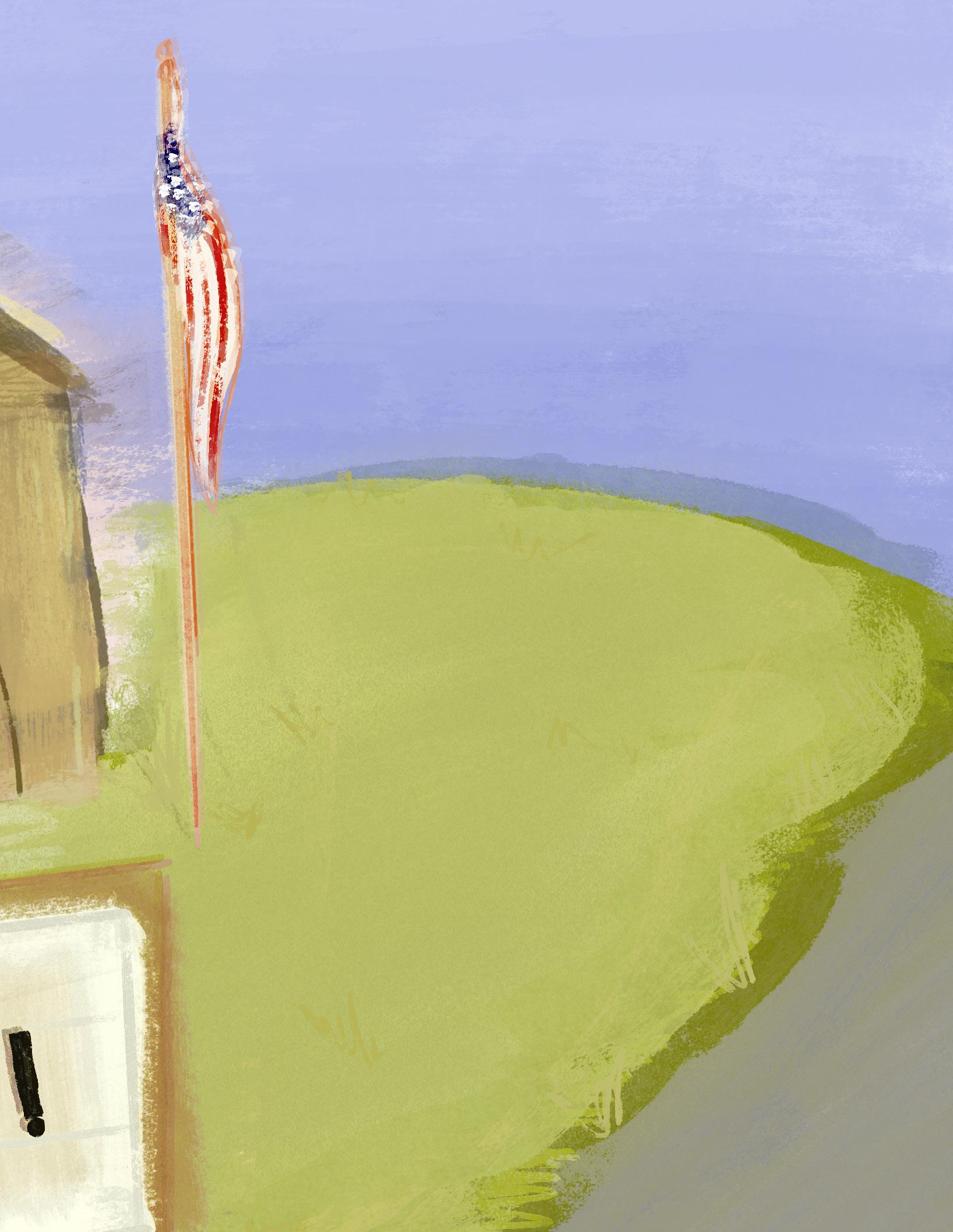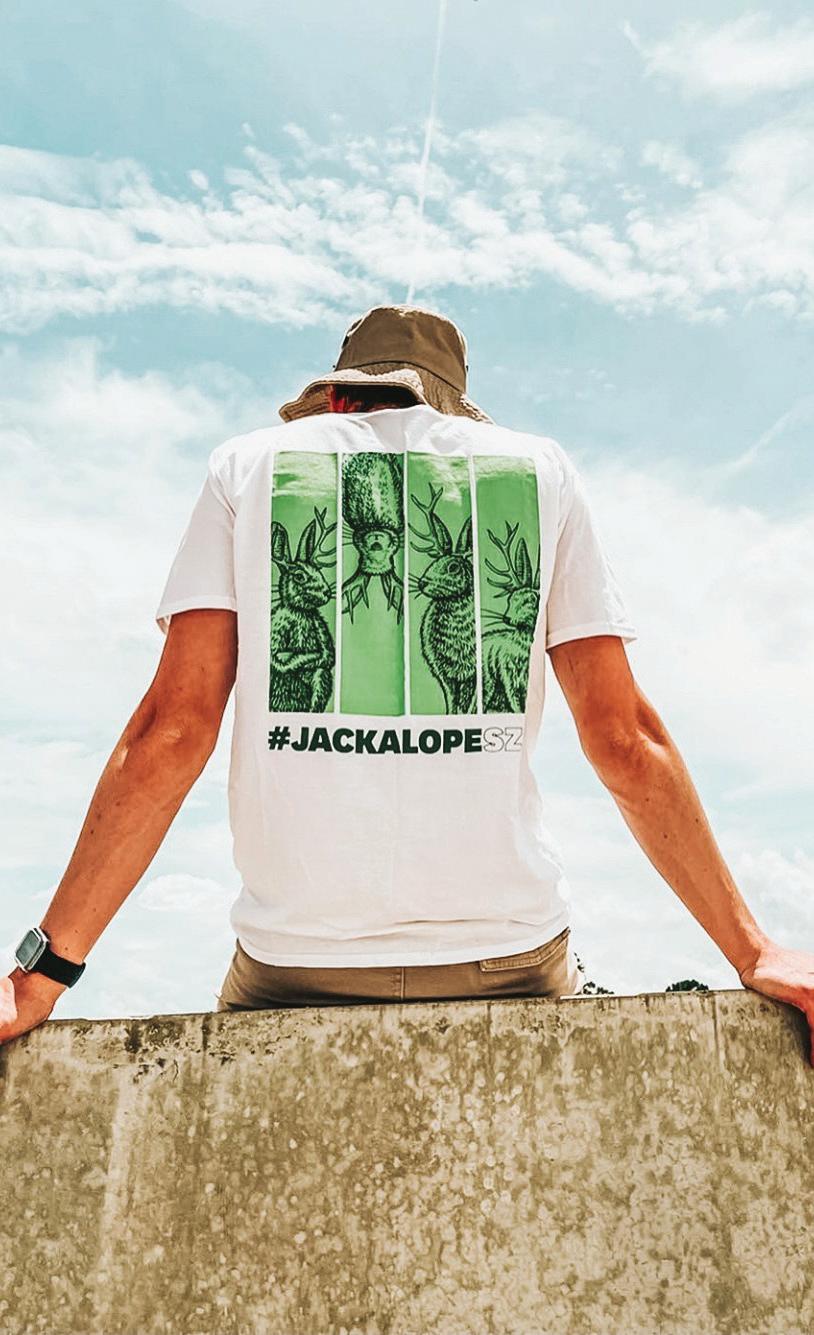




EXECUTIVE EDITOR
Katrina Michalak
EDITOR-IN-CHIEF
Leah Mesquita
MANAGING EDITORS
Abigail Wilt
Natalia Jarrett
DESIGN EDITORS
Lavanya Paliwal
Paulina Soto
ENGAGEMENT EDITOR
Wendy Maddox
WRITERS
Jude Banihani
Bella Keenan
Lavanya Paliwal
Aleisha Paulick
Evan Silverberg
Aleah Steinle
Keyanee Walls
ILLUSTRATOR
Claire Chilton
PHOTOGRAPHER
Madison Koehler

Editor’s letter
History shows us that humans have always desired a sense of belonging. We seek safety in numbers, exercise conformity and rely on collectivity to show us the right direction. Whether we mean to or not, gathering in groups — crowding, bunching or herding — is a natural part of our lives. We asked writers to investigate this phenomenon further, dissecting the patterns and like-mindedness that exist among us.
In this issue, some writers looked toward topical trends like the popularization of Asian products, cancel culture and Taylor Swift. Others dug into the recent uptick in cosmetic procedures, while another reported on the die-hard sports community. In a satire, one writer explored censorship and its tie to current events. Finally, our feature story examines the relationship between religion and policy.
By Aleisha Paulick
Photos by Madison Koehler and Wendy Maddox
The phrase “name one good thing about Asians” still dwells in my mind to this day, even after three years. I don’t remember the class I was in, nor what led to the conversation, but I do recall people I considered my friends looking at me and saying these words.
In junior year of high school, I shared a table with two of my friends: one who I’d known since fifth grade, the other my water polo teammate.
I don’t remember much of the conversation. All I remember were the words “name one good thing about Asians” coming from the mouth of my teammate, followed by my other friend blaming COVID-19 on the entire Asian population.
I immediately wanted to defend my community. I wanted to scream and shout at them for disrespecting my culture, my identity, my existence, but no words came out. Instead, I turned my head away, stuck and speechless because I was consumed by what I heard. I had never experienced this kind of prejudice before.
During my next class with them, I sat at a different table, still bothered by what they said. At first, they didn’t notice me, but then one glanced in my direction, questioning my avoidance. I explained that their comments agitated me, and they responded with annoyance, as if I were being too sensitive. They didn’t apologize or try to correct any misunderstanding. One of them didn’t even acknowledge that
I moved tables or that the comment bothered me. The other did, but didn’t understand why I was upset because, according to them, “it was just a joke.”
Despite experiencing this prejudice, I now realize the irony of the situation. As my community continues to be subjected to hate, our culture remains appropriated and popularized at others’ convenience, even with the outside backlash.
When the COVID-19 pandemic caused nationwide restrictions like wearing masks and quarantining in 2020, Asian communities were deeply affected, especially because the initial cases originated from Wuhan, China. As a result, individuals like myself became vulnerable to hate and discrimination.
In 2020, 4,431 hate acts were reported according to Stop AAPI Hate, a website created that year to document COVID-19-related anti-Asian racism by AAPI Equity Alliance, Chinese for Affirmative Action and San Francisco State University’s Asian American Studies Department. These cases include acts like harassment, physical harm, institutional discrimination and property harm.
Over three years, 12,255 anti-Asian hate acts were reported. However, these statistics only reflect cases that were reported to Stop AAPI Hate.
To combat this discrimination, former President Joe Biden signed the
COVID-19 Hate Crimes Act into law on May 20, 2021.
By January 2025, online slurs toward Asian communities increased by 66% since the presidential election, but slurs aimed specifically at South Asian people rose by 75%. In December 2024, physical violence threats against Asian communities also saw a 59% spike, while anti-South Asian threats displayed an 88% increase compared to November.
Despite an uptick in anti-Asian racism over the last five years, there seems to be a thriving interest in Asian-specific products like matcha and K-pop.
Between 2020 and 2023, matcha remained a fixed line in popularity with slight increases and decreases, according to Google Trends.
However, it later showed a gradual rise toward the end of 2023, reaching its peak in the summer of 2025.
Matcha is a powdered ceremonial green tea originally from China, but was later introduced to Japan in the 1100s by Zen monks. It is also essential in traditional Japanese tea ceremonies known as chadō or sadō., Murata Shukō, a disciple of Zen master and Abbot Ikkyū, is credited with founding it.
Kumiko Hirano Gahan, an associate teaching professor, said traditional tea ceremonies have a strict and ordered routine. She said there is a certain way to walk, serve, prepare and drink matcha.




“How you pick up the lid, how you wipe the teacup and all that, everything is set,” Hirano Gahan said. “You use matcha to make that tea in a formal way and serve it to your guest as a host. As a guest, (sweets are) served first to enjoy (with the tea).”
Due to a rise in demand, there is now a global matcha shortage. Additionally, Japan is also struggling to compensate because of both the lack of farmers and the recent rise in heat the country has been experiencing. Hirano Gahan said the shortage is a double-edged sword.
“We can’t complain because business is there but some people are not happy because something they could enjoy in their daily life is not easily available,” Hirano Gahan said.
Aside from matcha, anime — a Japanese animation style — has also gained popularity. One recent example is the movie “Demon Slayer: Kimetsu No Yaiba Infinity Castle,” that released in the United States on Sept. 12. It received both a 98% approval rating on Rotten Tomatoes and earned approximately $128 million domestically, according to box office reports.
Modern anime has existed since 1956 and was initially intended for Japanese children; however, it gained popularity through shows like “Dragon Ball Z” and “Pokémon.” Despite the style already being well-known, Nafisha Patwoary, a sophomore studying computer science, said it started out with a niche fanbase.

Now with releases like “Demon Slayer” and celebrities like Megan Thee Stallion expressing interest in anime, there seems to be a growing appeal. However, Patwoary finds the shift from niche to trendy absurd.
“Everyone called you weird for it,” Patwoary said. “People literally judged who you are because of that and now there’s this whole 360 like ‘Oh yeah, that’s so cool.’”
South Korea is also receiving an increase in attention due to K-pop and K-dramas. Kayla Kim, a junior studying graphic design, said that people only know this aspect of South Korean culture and not anything else.
“If you’re someone who’s a fan, who loves the culture, who loves all the pop
culture aspects, it would be nice to dig deep into the culture, the history, the buildings and architecture,” Kim said.
Another issue that Kim brought up was the romanticization of South Korean individuals due to K-dramas.
“A lot of girls just [say] ‘Oh, all Korean men are going to act this way’ or like ‘Oh, they’re gonna fall in love,’” Kim said. “There are terrible men in Korea and there are men who are just normal people.”
Additionally, there are TikToks where people seem to use “Korea” as an adjective. Because of this, Kim feels that the word has become an accessory.
“It’s not the best feeling, I will say, because we’re people too,” Kim said.
Although these products have risen in popularity, they are from East Asian countries like China, Japan and South Korea. South Asian trends do exist; however, they’re often rebranded or Westernized, like chai.
Masala chai is an Indian black brewed tea mixed with a variety of spices like ginger and cardamom. Masala means “spices” and chai means “tea,” but it is often referred to as chai tea outside of India. This beverage can also be ordered at Starbucks and becomes especially popular during the fall season when it’s mixed with other flavors like pumpkin.
Another example is the dupatta, a traditional long piece of cloth from South Asia worn over the shoulder and head. Rather than reference its formal name, it’s become a fashion trend on TikTok called the “Scandinavian scarf.”
Additionally, Prada recently received backlash after it featured footwear that mirrored Kolhapuri Chappals in seven of their looks at the Spring 2026 Menswear Show. Kolhapuri Chappals are handcrafted leather sandals that Indians have worn for centuries.
The Italian fashion brand faced controversy for this due to both cultural appropriation and design theft from India. While Prada issued an apology and a statement claiming they recognized the origins, they did not initially provide credit.
Patwoary said that while it’s good they eventually gave credit, it still doesn’t compensate for failing to initially present it.
“South Asian culture is slowly, slowly getting more appropriated,” Patwoary said. “If you’re not giving credit, it’s appropriation, but if you give credit, it’s appreciation.”
Disregard for other Asian countries
Navjot Singh, a senior studying digital marketing and is Punjabi, said people state they like Asian cultures but mainly refer to East Asia, often disregarding other regions.
“If I ever introduce myself like ‘Yeah, I’m Asian or South Asian,’ people would be confused that I don’t look like the media they’ve been consuming or what they’re expecting,” Singh said.
Singh also recalled witnessing hate toward South Asians, especially toward Indians, through mediums like memes. A common theme he noticed is the characterization of Indians as unattractive.
However, this hate declined once KATSEYE’s Lara Raj, who is Tamil, gained popularity. Singh added that this is the first time he’s seen acceptance for a South Asian in the media, but that it’s still upsetting.
“All it takes is something trendy and hot to be put in front of you to respect us as people,” Singh said. “It’s sad to know that the world is still in a state or our country’s still in a state where not everyone is fully accepted when you don’t have a positive influence for them.”
Another aspect of the disregard is classifying all South Asians as Indians. South Asia consists of Afghanistan, Bangladesh, Bhutan, India, Nepal, Pakistan, Sri Lanka
and the Maldives. It’s also inaccurate to label all Indians the same, as there are countless cultures in India.
Patwoary is Bangladeshi, but she recalls people mistaking her for Indian or simply dismissing her because they did not understand her background. This lack of understanding is what she said leads to the disregard for South Asia.
“People dismiss me all the time and people dismiss what they don’t know,” Patwoary said.
Although South Asia is often disregarded, it’s not alone, as there are other regions like Central Asia and Southeast Asia that share this experience. Both are overlooked and there isn’t exposure for those countries.
Patwoary also believes the reason people gravitate toward East Asian products is because of pop culture. However, even with the fascination toward East Asia, Patwoary said people only know about the popular aspects rather than the traditions and history.
Brian To, a junior studying organizational leadership and project management, also agrees that people are only interested in Asian culture because their products are popular. He also believes this could be beneficial because it provides exposure to these countries by boosting tourism.
“It’s never gonna hurt having more people accepting of your culture,” To said. “It’s just gonna hurt if more people become more aggressive against your culture.”
While To thinks the trends can be good, there was a point when he didn’t view them positively and felt there was too much attraction. This was due to witnessing Westerners impose their values; however, To
came to terms that this is inevitable. “It’s not like I can stop it or prevent it in any way,” To said. “(So) instead of letting the boat crash into the wall, I should help steer the boat into a more clear path.”
Whether or not the spotlight on Asian cultures is positive, To said the lack of exposure is why there are stereotypes and hatred persists.
“There’s this saying that all exposure is good exposure and even bad exposure is exposure,” To said.
As someone who is Indonesian-American, I agree with the disregard for our heritage because I grew up in a predominantly white and Hispanic community. I was often the only Asian, and even if there were others, I was the only Indonesian. People would also often mistake me for other ethnicities like Filipina or disregard my identity altogether.
Despite Indonesia being the fourth most populated country in the world, there seems to be a lack of acknowledgement among Westerners. The country consists of about 17,500 islands, meaning there are many distinct cultures within the country, yet people only really know Bali – a popular tropical vacation destination.
Although there may be a lack of exposure and understanding, that is no excuse for the Asian community experiencing discrimination and hate during and after COVID-19. Society may have forgotten; however, I, along with the Asian community, have not.
One person may have doubted the impact of the Asian community by telling me to “name one good thing about Asians.” But given the popularity of many Asian or Asian-inspired trends and products — whether they are westernized, rebranded or not credited — it seems there actually happens to be countless good qualities.
LEAD. LED. LOST. LEARN. FREE. FAITH. FAIR. FEAR. GRAZE. GAZE. GLAZE. GAMES.

By Bella Keenan
by Lavanya Paliwal and Abigail Wilt
It was a boisterous night in Philadelphia on Feb. 9 when Dan Starke, a freshman studying sports journalism, marched down Broad Street. Fans decked out in green were packed shoulder to shoulder so tightly that he couldn’t see past the person in front of him.
“Yo dude, let me get on your shoulders,” Starke said to his friend. “I want to see.”
Garbage trucks barricaded the area, enclosing thousands of Eagles fans to one street.
“Eventually, it got to the point where fans couldn’t even move,” Starke said. “I climbed on top of a garbage truck, and then my friend climbed a pole.”
Unlike the Eagles’ Super Bowl win in 2018, the Philadelphia police refrained from pulling fans off the poles while cheers and loud noises erupted throughout the night.
At sporting events, there are several different types of fans, which typically fall under three categories: casual fans, bandwagon fans and die-hard fans. Casual fans attend a few games and may not show enthusiasm the entire time — they make up the majority. Bandwagon fans are supporters
because a team or player is performing well, but when the team loses, they are hastily off to the next team.
“Going to all of the games, traveling wherever the team goes, being there and supporting them,” Branden Tsethlikai, a 37-year-old die-hard Eagles fan, said. “To me, that’s what a die-hard fan [is].”
Sports have the power to unite people of all backgrounds and also tear them apart. Historically, people have participated in sports for around 15,000 years, documented by cave drawings of wrestling matches and races. From the first ancient Olympics in 776 BCE in Greece to the gladiator games from 105 BCE to 405 CE in Rome, to soccer in 1800s England, sports have evolved, but one thing remains the same: their respective die-hard fanbases.
Tsethlikai is from the Zuni Pueblo reservation in New Mexico. Since New Mexico doesn’t have professional sports teams and his family wasn’t keen on sports, Tsethlikai didn’t become a sports fan until middle school, when he began playing and watching football.
“I became a big fan of the Philadelphia Eagles around 2000 because I liked the colors, the whole idea of
the city of brotherly love, Philadelphia, and what the eagle represents and symbolizes,” Tsethlikai said.
Starke became a die-hard Eagles and Philadelphia Flyers fan in eighth grade during the COVID-19 pandemic when there was “nothing to watch.” Influenced by his dad, a devout Flyers fan, Starke became one too.
Both Starke and Tsethlikai feel differently about violence in the Eagles’ fan base.
“Most Philly sports fans already have a bad rap for things that have happened 20 to 30 years ago,” Starke said. “I still think that is a little ridiculous for people, like ‘Oh, you threw snowballs at Santa Claus.’”
The Eagles are generally known for having a “passionate” fanbase, according to Starke.
“People tell me, ‘[Sports fans] from Philly are crazy or they’re ridiculous,’ Starke said. “We just have passion.”
Tsethlikai connected with the Eagles West fan club at Rockbar in Scottsdale.
“It was a good feeling to go there and know there are other Eagles fans,” Tsethlikai said.


Starke usually hears opposing fans swear at each other, but has not seen physical violence at a sporting event.
“I have seen videos when the Eagles won the Super Bowl of people starting fires,” Starke said. “I didn’t personally witness it, but it definitely does happen.”
Tsethlikai’s experience as an Eagles fan who is physically distant from Philadelphia remains steady.
“Even when the Eagles came out here to State Farm Stadium, I never saw or experienced any hostility or violent acts,” Tsethlikai said.
When Reddit users in the r/ASU com-
munity were asked about violence at sporting events, one user responded saying:
“Violence has no place in sports and rivalries... though an exception in the case of UofA might be made,” an anonymous Reddit user said. “In the 1986 Territorial Cup, UofA beat ASU, spoiling their undefeated season and keeping them (temporarily) from the Rose Bowl. As if the taunts from the UofA fans in the stands weren’t enough, UofA fans had the audacity to rush OUR field and try to take the goal posts. Collective groans and audible sighs turned to wild cheers as the police and DPS, both foot and mounted units, set upon their students with batons and tear gas. A nice little concession for a truly
mentality
Throughout millennia, fans continue to show up to support their teams, but with this passion comes conflict.
“At the end of the day, you need your fans to buy into the rivalry. There needs to be a starting point that ignites it,” Mihir Sinhasan, a senior studying sports journalism, said.
Many rivalries are geographically-based, like the rivalry between ASU and UA. Some rivalries are based on where the majority of fans live, with many BYU fans located in the Valley. other rivalries may even be politically

motivated, according to Sinhasan many BYU fans located in the Valley. Other rivalries may even be politically motivated, according to Sinhasan
His family immigrated to the United States from India, where the most popular sport is cricket. India and Sri Lanka are set to host the cricket world cup in 2026.
“India and Pakistan have the biggest rivalry in all of cricket because of the political differences they’ve had over the past 75 to 80 years,” Sinhasan said. “A lot of the disputes that they have in politics translate to sports.”
If Pakistan makes the final, Sri Lanka
will host it, due to India and Pakistan’s intense rivalry.
Recently, ASU football started a rivalry with BYU. Tension increased between the teams when Sun Devil fans rushed the field one second early during the second-to-last 2024 regular-season game. With both teams’ recent move to the Big 12 Conference and many BYU fans living in Arizona, the rivalry continues to grow.
Sinhasan witnessed some ASU fans taunting BYU fans and their players, while most rushed the field.
Although unruly sports fans are a minority compared to all sports fans,
they may seem like the majority due to their news coverage and their social media presence.
“BYU fans have started telling themselves, ‘Hey, ASU fans are not good. If they win, they’re going to be rowdy,’ in Tempe, a very big party school,” Sinhasan said. “It shows in their fans.”
Groups of fans and players tend to follow a leader, according to the Harvard Business Review.
“The coach is usually the [leader], because the coach will talk to the players during practice and during their film sessions and say, ‘Hey, this rivalry has history.
The people care about this rivalry, we should care about it as much as they do, because it’s deep and it’s historic,’” Sinhasan said.
The dark side of die-hard fans
Die-hard fans will often get tattoos of their favorite teams, name their kids after their favorite players, spend thousands of dollars on their teams and sometimes, even participate in violence.
Alisia (Giac-Thao) Tran is an ASU associate professor in the School of Counseling and Counseling Psychology with a focus on student athletes and minorities.
“Sports are meant to connect people and give them a sense of exhilaration, but they’re not meant to threaten and create violence,” Tran said.
In a 2023 survey by Sportsbook Review, 39% of NFL fans said they witnessed crimes at or around a stadium, including physical violence and public intoxication. Factors such as alcohol and mobile sports betting have led to higher rates of violence at sporting events.
Eighty-four percent of Americans say they drink alcohol while watching football, according to the Harris Poll.
“I never went to a Bengals game in Cincinnati [as a kid] because of the fights that happen and you’re in a situation where people may be drunk,” Sinhasan said.
Alcohol consumption at sporting events is common and even encouraged by the team partners and advertisements.
“There’s a million advertisements for alcohol everywhere around the arena,” Starke said. “They [vendors] are walking up and down between the stands, selling alcohol too.”
The Texas Comptroller of Public Accounts found the Dallas Cowboys made $36 million in profit from alcohol sales in 2022. Alcohol sales often drive the highest profit margin for teams, about 90%.
Alongside increased alcohol consumption, mobile sports betting has surged in the past eight years. The Supreme Court overturned the Professional and Amateur Sports Protection Act in May 2018, which prevented sports betting from expanding. Sports betting is now legal in 38 states.
Tsethlikai, who works at an Arizona casino, witnesses customers bet on sports every day.
“[When they lose a bet] it’s just the usual: swearing, cussing and ripping up their bet slips,” he said.
Research published in the National Library of Medicine found that domestic violence rates can increase by 10% after an upset loss, with a University of Oregon study saying this increase is highlighted more in states with mobile sports betting apps.
“People’s testosterone [levels] will raise when they’re [just] making a bet on a coin toss,” Tran said.
Dopamine “feel good” levels also increase while sports betting, according to Tran. The wins can feel great, but the losses after a sports bet may lead to intimate partner violence (IPV) in a few cases.
“IPV can really [highlight] how people justify or rationalize a behavior,” Tran said. For example, someone may say to their partner, “‘All the alcohol made me do it. You talked when I told you not to.’”
Most studies regarding violence at sporting events pertain to football, a full-contact men’s sport.
However, unruly behavior at women’s sports also occurs. For example, during several WNBA games in the 2025 season, people threw sex toys at players, sparking backlash.
MJ Simpson is a Phoenix native and former Phoenix Mercury hiphop dancer from 1997 to 2001.
“Those young men who were part of the cryptocurrency world, who were dared to do it, really soiled the experience that the WNBA protects and has, which is that this is a family-friendly sport,” Simpson said.
Simpson said throughout her 28 years of being a Mercury fan, she has never witnessed violence at the games. The WNBA, which caters more to women and LGBTQ+ individuals, has created a “safe space,” according to Simpson’s friend.
“When I went to the last Cardinals game, I swore I was never going back,” Simpson said. “I felt like there was too much alcohol and too much testosterone for way too big of a crowd.”
Around 45% of women do not feel comfortable alone at their NFL team’s stadium, according to Trine University.
Some fans feel safe in a family environment, while others savor the rivalries.
“I enjoy the game more when everyone’s going crazy,” Starke said. “Even if we lose, if we’re energetic about it, it’s fun!”
Ultimately, die-hard sports fans watch sports for a reason.
“We watch sports to let go of everything else that’s going on in our lives, for us to take a break and to just relax,” Sinhasan said. “That’s the beauty of sports, because we can all unite [around] that one thing.”




Christianity’s role in shaping political ideology and action
By Aleah Steinle
Soto
For decades, Christian faith has been slowly declining in the U.S. However, recent data suggests this trend may be stabilizing. A study by Pew Research Center found that the share of adults identifying as Christian has dropped from 78% in 2007 to about 62% today.
Although overall Christian numbers have been declining, some groups — particularly Evangelical communities — have become more vocal in political spaces. While this doesn’t represent all Christians, it does highlight a population whose religious beliefs strongly influence their political engagement.
Jason Bruner, a professor at the School of Historical, Philosophical and Religious Studies, said this overlap between religion and politics isn’t new — it’s a repeated American tradition of moral and spiritual language being used in public life. But what’s shifted,
he noted, is the tone and its message.
“Religion has always been a part of American politics — it’s not new,” he said. “What’s new is how totalizing it’s become for some. It’s not just an influence anymore, it’s identity.”
He added that the blend between belief and ideology has become especially visible because of social media and modern political organizing.
“Today, people can attend a service by Zoom — they can scroll and see some kind of inspirational message in 30 seconds,” he said. “The sense of community is much more often thought about digitally rather than participating in this physical congregation with people that you meet with once or twice a week.”
Figures like Charlie Kirk have helped reframe political activism as a religious calling. Kirk, once known for his sec-
ular conservative messaging, began addressing pastors and congregations directly through his “Turning Point Faith” initiative, encouraging believers to view civic participation as a spiritual duty.
In the years following Donald Trump’s first presidency, Christian nationalism and the language of “spiritual warfare” gained visibility in certain conservative movements — from the New Apostolistic Reformation, whose leaders frame politics as a divine battle between good and evil to groups tied to the ReAwaken American Tour, where pastors, politicians and influencers blend revival-style worship with campaign messaging. This convergence between faith and ideology has redefined how many conservative Christians view their role in democracy.
However, not all believers see faith

and politics as inseparable. Many pastors and theologians have voiced concern that tying Christianity too closely to political identity risks turning the gospel into a partisan brand.
When a quiet Sunday morning returns, Yanel Zazueta takes her seat among familiar faces, with her pastor’s voice steady from the pulpit. In a time where some churches have turned services into political stages, her pastor reminds the congregation that faith and politics “have distinct roles.”
He often turns to Matthew 22:21: “Render to Caesar the things that are Caesar’s and to God the things that are God’s” — a verse that Zazueta said her pastor uses to illustrate how church and government should remain separate.
“Our faith should be based on God, not humanity,” she said. “The government is responsible for civil order,
but the church’s role is spiritual: spreading the gospel, loving God and loving people.”
Before each sermon, Zazueta said her pastor begins with a prayer asking for “the Holy Spirit to work through him,” so that his words come from faith, not flesh.
However, some congregants have expressed frustration over the absence of political talk. When this happens, her pastor doesn’t shut that conversation down; he invites it. But he also remains firm in the church’s purpose. “If that’s what people are looking for, there are churches that do that,” she recalls him saying. “But it won’t be this one.”
Amid political tensions, especially within the Christian community, Zazueta said her pastor’s recent sermon series focuses on humility, communication and breaking generational cycles, reflecting his belief that “loving God and loving people” should guide civic life more


than ideology.
“We can disagree with people we love, politics shouldn’t define our relationships or our faith,” she said.
To her pastor, political endorsements from the pulpit reflect a misuse of influence. “He believes that kind of energy could be used to serve the community instead,” Zazueta said, referencing mission trips and aid projects that provide housing, clean water and food while spreading ministry. “That’s how we’re called to use our voices — to help people, not to idolize a human more than God.”
While some pastors like Zazueta’s work to keep faith distinct from partisanship, others have embraced a different approach — one that merges spiritual devotion with political fervor.


Where pastors once stood behind pulpits delivering sermons, similar scenes now play out in arenas. Stadium lights replace stained glass and worship bands share the stage with political speakers. Crowds sing praise songs, wave flags and listen as speakers link faith with the future of the country. For many, it’s a powerful expression of shared conviction — for others, it blurs the line between religion and politics.
These ideas reach beyond church walls. The “seven mountains” belief — a concept that calls Christians to shape every part of society, from classrooms to Congress — has also seeped into conservative politics, seen in efforts like Turning Point Faith and local school board movements that frame civic engagement as a divine mission to reclaim culture.
Even for those who don’t directly engage with the movement, its language of divine purpose has become a familiar thread in modern Christian political talk.
This growing integration of faith and politics was made especially visible after Kirk’s assassination on Sept. 10 during a stop on his debate tour at Utah Valley University. Nearly 100,000 people attended his memorial in Glendale, Arizona, where prayer, worship music and political speeches shared the same stage.
Throughout his later years, Kirk’s message evolved, blending worship with activism, with his events often resembling religious revivals. For many young conservatives, the combination of belonging, moral clarity and national identity offered a powerful sense of purpose, one that blurs the lines between civic engagement and religious conviction.
At college campuses across the country, including ASU, that same overlap is increasingly evident. Faith-based student organizations, conservative clubs and politically active ministries are bringing
conversations about morality, government and personal conviction to the forefront — shaping how young voters experience and express their beliefs.
Although several on-campus conservative Christian student organizations at ASU — including TPUSA at ASU, Students for Life, Young Americans for Freedom and ASU College Republicans — did not respond for comment, they remain heavily influential.
The public statements and online posts from these groups greatly reflect their beliefs: that faith and political engagement are inseparable. TPUSA’s mission, for example, focuses on educating students to defend freedom and limited government. Similarly, Students for Life frames political activism as a moral duty, encouraging Christian students to bring biblical truth into the public square.
In Sept. 2024, Kirk visited ASU for a “Greeks for Trump” voter registration event alongside Kari Lake. While Kirk handed out red MAGA hats to students, he was encouraging students to register and vote in the upcoming election.
After his death, a candlelight vigil co-hosted by TPUSA at ASU and the College Republicans drew around 10,000 registered attendees to Desert Financial Arena. The event featured prayer, worship music and speeches honoring Kirk’s legacy.
For many who share these views, political engagement isn’t seen as a distortment of faith, but an extension — a way to protect the values they feel are under threat.
In recent years, the overlap between faith and patriotism has become more than just a passing trend — it’s a movement shaping American identi-
ty. A 2024 Public Religion Research Institute survey found that nearly 30% of Americans either align with or sympathize with Christian nationalism.
Groups like TPUSA echo that sentiment in their messaging, championing what they call “traditional American values” — family, freedom and respect for life.
At events like TPUSA’s 2024 AmericaFest, a blend of faith and politics takes center stage. Speakers, including Kirk, credited electoral victories to divine favor, blurring the lines between political momentum and spiritual mission.
Bruner pointed out how this generational divide is more visible among younger Christians. While some have embraced a more active, external expression of faith that aligns with political causes, others are quietly resisting.
“Younger Christians are navigating a really complicated space where many of them are trying to figure out how to hold onto faith without it being hijacked by politics,” Bruner said. “But at the same time, they see their peers who connect faith with activism and feel drawn to that sense of purpose and belonging.”
For some, this struggle has become personal. Maddie Brooks, a junior studying medical studies and health solutions, said her faith helps her “stay sane and show love to others,” however, she believes politics is not the place for religious influence.
“My faith is strong and I do think that in some scenarios it is appropriate to share the word and talk about what you believe in; however, to me, politics is not that space,” she said. “Politics, to me, encompasses the space for conversations about how we as a country can improve and sustain the well-being of all people, and provide equality and the appropriate application of basic human ethics to all scenarios that take place in this country.”
She noted how she’s seen faith become more of a talking point among students in recent years, especially concerning controversial issues.
While she believes it’s OK to let faith guide one’s own morals, she worries about religion being used to impose those values on others.
“In a country that accepts and supports anyone and everyone, I think there are a lot of issues right now that are being heavily influenced by religious beliefs, making the separation of church and state feel very foggy,” Brooks said.
Her concerns extend beyond politics to Christianity itself. “The rate of young Christians is already on such a decline, and the chaos of this integration into politics is only going to cause a
bad reputation for Christians and steer people away,” she said.
When she sees large faithbased political rallies, Brooks said she feels uneasy for those involved.
“I wish they would be content with their individual journeys with Christ and not feel the need to change other people’s perspectives based on a religion that individuals might know nothing about,” Brooks said.




CREDITS: LAVANYA PALIWAL

How restorative justice could be the answer to our ‘cancel culture’ problem
By Keyanee Walls
Illustrations by Paulina Soto
They were dropping like flies. At a certain point, it felt like every time I opened my phone, it was someone new. Though I wasn’t familiar with a lot of them, and others I never really cared for anyway, it was sort of jarring to see just how many influencers had deplorable digital footprints.
I didn’t have much else to do. It was 2020. The world was shut down and these creators were my main source of entertainment. I joined in on the jokes and mass unfollowings, telling myself and anyone who would listen that this was accountability.
There were a few cases where “cancel culture” really worked, and influencers were successfully deplatformed for their problematic behaviors. But for the rest of them, there was little change. Within weeks, everything was back to normal — and no one was truly held accountable.
When this practice became obsolete, I started to question just how effective it really was.
Audiences grew less concerned with redemption and became more focused on tearing down these figures completely.
When punishment became the sole priority, it became apparent to me that cancel culture was not working — but what could replace it?
#Isoverparty
The notion of canceling a public fig-
ure through a series of online call-outs can be traced back to Black Twitter in the mid-2010s, where individuals of the community would engage in discussions surrounding emerging social movements like #MeToo and Black Lives Matter, as well as the problematic behaviors of celebrities and brands.
At this point, much of this discourse was rooted in opening up conversations about controversial figures, but it also included more light-hearted jabs between fans of different celebrities.
One prominent example of these early cancellations involved singer-songwriter Taylor Swift, reality television star Kim Kardashian and her then husband, rapper Kanye West. According to Know Your Meme, “#isoverparty” was first used by an X user in 2015, claiming Swift as its first victim. A year later, the hashtag began trending after a phone call between Swift and Kardashian surfaced, prompting fans to question Swift’s authenticity.
As a new decade approached, cancel culture began to be associated with a far more aggressive identity.
On May 10, 2019, beauty YouTube influencer Tati Westbrook posted a since-deleted video titled “BYE Sister,” which detailed the feud between Westbrook and fellow YouTube influencer James Charles. In the video, Westbrook discussed her feelings of betrayal after Charles partnered with a competitor to her beauty supplement brand. She then proceeded to make accusations toward Charles, alleging he was guilty of pred-
atory and manipulative behavior. The release of this video resulted in Charles losing 2.6 million subscribers over the course of three days and facing an upheaval of public backlash.
Just over a week later, Charles posted his response video titled “No More Lies,’ in which he apologized for his betrayal to Westbrook and denied the predatory claims. With this video, Charles began flipping the narrative, and fingers started pointing at Westbrook.
After attempting to pin blame on YouTube influencers Shane Dawson and Jeffree Starr, Westbrook fell almost completely out of public favor. Despite the feud, both influencers continue to post content; however, Westbrook’s engagement has decreased significantly, while Charles’ subscriber count currently stands at 24 million.
This scandal marked a turning point for how creators approached public backlash as well as how audiences chose to interact with controversies. With “BYE Sister,” viewers began to play an active role in the proceedings of public drama as each new detail was uncovered.
In 2023, YouTuber Colleen Ballinger, also known as Miranda Sings, took a unique route in addressing allegations that accused her of hav-

ing inappropriate relationships with underage fans.
In a 10-minute video titled “hi.,” Ballinger strummed on a ukulele while singing about the “toxic gossip train,” refuting the claims in her own special way. The song almost immediately became a joke across the internet, with audiences expressing collective dis-
belief toward Ballinger’s choice of “apology.”
Ballinger still has an online platform and uploads content regularly; however, the fallout from this controversy irreversibly damaged her reputation. Despite this, Ballinger has yet to fully address the scope of the allegations made toward her, expressing little remorse for the alleged actions that initially got her in hot water.
Currently, one of the most popular forms of canceling arises in resurfaced screenshots or videos from a creator’s
past. In August 2024, influencer Brooke Schofield was under fire after her old tweets defending Trayvon Martin’s killer, saying slurs and admitting to racist behaviors were brought to light.

In 2022, I was introduced to the idea of transformative justice. In a workshop that lasted no more than a couple of hours I was, for the first time, asked to reflect on the effectiveness of our retributive justice system.
Transformative justice, which exists under the umbrella of restorative justice, is an abolitionist framework of accountability that aims to prevent harm by addressing underlying systems that may give rise to it.
Fidelia Igwe, founder of Equitable Minds LLC, led this workshop and applied this line of thinking to scenarios often faced by students in conflict, offering tools for intervention in these situations.
A major hallmark of restorative justice is an emphasis on reconciliation through community involvement and victim-offender mediation.
Gregory Broberg, a courtesy affiliate at the School of Social Transformation, identified the two overarching pillars of restorative justice — “repairing harm and healing for victims.”
In practice, a traditional restorative justice process would encompass some sort of dialogue between an offender
and their victim. This could be through circle sentencing, victim panels or any meetings that give victims the opportunity to speak with the offender about the harm caused to them. They are also able to come up with a collaborative solution to repair said harm and hold the offender accountable.
“Retributive justice holds people accountable to or for something, an act, whereas restorative justice holds someone accountable to someone,”Abigail Henson, an assistant professor at the School of Criminology and Criminal Justice, said in reference to Danielle Sered’s 2019 book “Until We Reckon.”
This human-centered method of

accountability offers many measurable benefits to both individuals involved and community members impacted by harm.
“For victims, it’s all about restoring their voice and giving them agency in this event, whatever that event is,” Broberg said. “For the offenders, it’s an opportunity for them to accept accountability for the harm they did.”

ture could piece into this conversation. When someone is being canceled, the ultimate goal is punishment. Through shunning, mass unfollowing, floods of negative comments and in some cases, contacting an offender’s school or place of work, problematic figures are given few opportunities to redeem themselves.
individuals who cause harm easily regain favor from those who were not affected by their actions, and who are sometimes even able to profit from being “canceled.”
Restorative justice offers victims an important chance to be completely heard and have a role in how their own justice will be carried out. For offenders, restorative justice can provide a unique opportunity for growth and rehabilitation.
“The way we’re going about addressing harm is not working, and therefore, there has to be another way,” Henson said. “And another way that has been demonstrated with data to have high rates of satisfaction from those who have been victimized, as well as high success rates in terms of increased well-being and decreased likelihood of engaging repeatedly in harmful or illegal behavior, is restorative justice.”
According to a Park University article from 2024, when applied, restorative justice models can lead to 10% to 25% decreases in recidivism rates, as well as promote victim satisfaction rates.
According to Henson, restorative justice “shifts culture by changing our perspectives of accountability” and creates an understanding of why we want to punish, why we cause harm and why violence is cyclical.
In reflecting on the effectiveness of punishment in response to harm, I’ve thought a lot about how cancel cul-
When an influencer posts an apology for the harm they’ve caused, it’s treated as a public spectacle. Will it be a Notes App apology? Are their tears even real? Why are there cuts in the video? The new standard for influencer apologies is extremely formulaic, and can make it difficult to tell which parts are out of genuine remorse or just to avoid further scrutiny.
More and more, it’s hard to distinguish whether audiences truly want to see a problematic figure held accountable and grow from their actions, or if they just want the figure’s head on a spike.
When influencers like Ballinger and Charles were facing cancellation, I was admittedly aboard the toxic gossip train. I interacted with videos and comments condemning their actions, and was entertained by the mass unsubscription watch parties. However, once the conversations died down and these figures were “successfully” canceled, it didn’t take long for their remaining supporters to voice their forgiveness.
In these situations, there is often conversation surrounding what communities are truly afforded the right to forgive these individuals. In Schofield’s case, for example, the offensive comments she made were directly harmful toward Black, Hispanic and LGBTQIA+ communities, so it should have been these groups leading the discussion in holding her accountable. This, however, was seldom the result. It can be extremely disheartening to see
In June 2024, TikToker Lilly Gaddis went viral after posting a video of herself cooking and casually using a racial slur, among other offensive language. Following public outrage from this video, Gaddis was terminated from her job and suspended from the app. These consequences, however, did little in pushing Gaddis to reflect on the harm she caused. In fact, she ended up doubling down on her actions and as a result, gained opportunities like being featured on podcasts and talk shows, expanding her platform even further.
Outcomes like this caused me to doubt the effectiveness of cancel culture and think about how the foundations of restorative justice could be applied as a more productive medium in ensuring problematic figures understand the harm they’ve caused, and are open to actively repairing it.
“People who tout themselves as abolitionists will also be calling for canceling people who have committed deep harm, but you can’t be an abolitionist and be calling for the canceling of anyone,” Henson said.
Within the limits of cancel culture, there is little opportunity for individuals to grow.
“You have to remember that people can grow from their past experiences, and if you allow them to grow and apologize … [You] allow them to better themselves,” Melina Becerra, a junior studying criminology and criminal justice, and forensic psychology, said.
Though the current mechanisms of cancel culture were spearheaded by Gen Z, many of its practices are no longer favored among the group.
“I feel like people are able to hide behind their screens, especially with cancel culture,” Maya de La Huerta-Kainz, a junior studying community health, said. “I think it promotes a lot of cyber-bullying and it doesn’t actually get any points across.”
Benji Perez, a sophomore with an undefined major, said that measures of holding figures accountable could be effective “if [figures] apologize to [those] they have offended and seriously take some progressive action
against what they’ve done.”
Translating the line of thinking in restorative justice models to the processes of gaining accountability from celebrities, influencers and brands could potentially motivate reform on a larger scale.
Since younger generations will hold positions of power in the future, they are the key to making the change, according to Henson.
“So if we can shift the way they’re thinking about it now, then once they get into office, they are going to be the people who are educated around these things [and] believe in the change that they’re trying to pass, and
will see it through,” Henson said. Restorative justice is not a perfect solution; in fact, a large critique of the system is that it allows offenders to avoid real consequences for the harm they’ve caused. However, restorative justice also gives offenders the opportunity to face consequences based on their victim’s decision, and are required to do the work to repair this harm in a way that their victim feels would bring them justice.
“Abolition isn’t about not holding accountability or creating chaos in the community, but rather understanding that nowhere in the definition of accountability is punishment,” Henson said.


A look into the popularization of cosmetic procedures in college
By Jude Banihani
Photos by Madison Koehler
J“ust one last poke,” the injector says. “And you’re done.”
She hands you a mirror and you look at two swollen lips. They’re a bit purple from the bruising, but you’re not worried, the injector says it’ll be about a week before the swelling goes down. So, you wait a week — it’s your first time getting filler, so you’re not familiar with the process. The week comes and goes, but by the end, you feel your lips are a tad smaller than the initial appointment.
“It’s fine, I’ll just go for the full syringe next month,” you think. The cycle repeats and within a year, your face is suddenly unrecognizable. Your lips that once had half a syringe of filler, now have three. Your nose that was once a collection of your ancestry, is now sloped to perfection.
It’s a choice to undergo cosmetic procedures. For the past 20 years, celebrities, influencers and even students have become more transparent about the work they’ve gotten done than at any other point in history. This wouldn’t be the case if it weren’t for the legal and societal freedoms granted by the feminist movements of the 20th century.


Many women feel these procedures empower them, maybe even improve their quality of life, but other women feel they reinforce the idea that a woman is defined by her beauty. There are, of course, women who lie in the middle, saying that if a woman feels unhappy with her features and has the means to change them, she should.
Every day, thousands of women undergo cosmetic procedures. These can range from a simple syringe of botox in the neck to a more complex breast augmentation. The ages of women seeking these procedures get younger through the years, with 21% of college students expressing interest.
The med spa industry has grown at a rapid pace over the last 15 years. Between 2010 and 2023, med spa locations nationwide increased from 1,600 to 10,000, and their revenue doubled. Much like other major cities, the area surrounding ASU has no shortage of med spa options.
Jett Summers is an ASU alum and the owner of Method Wellness & Infusion in Tempe. Prior to opening a med spa, Summers worked in the laser industry. He sold professional medical lasers to clinics and practitioners. Seeing the effect laser procedures had on patients’ lives, he decided to venture into the med spa industry.
“Say somebody had really bad cystic acne growing up and they have those acne scars,” Summers said. “For a lot of people, that’s an insecurity that they carry with them on their face every single day. So we’re able to eliminate those scars and give fresh, clean skin.”
Summers said he feels as though the med spa industry has gone through significant modifications as trends advance. Ten years ago, clients sought drastic, bold changes. Today, they seek minor, subtle fixes. According to Summers, every wellness facility has its own approach.
“You’d be surprised if you think that they’re coming in here for some crazy revamps or something like that,” Summers said. “A lot
of people are now on this wave of doing the bare minimum to get them the results that they need.”
Located on Mill Avenue, Method Wellness is close to campus. “Being close to ASU, you have a lot of first-time users of these things,” he said.
According to Summers, 90% of their clients are female, but there are males who also seek procedures. “Quite a few males are doing what you call ‘bro-tox,’ or Botox,” he said. “But I would say our main demographic is probably girls, age[d] from, I want to say 19 to mid-20s.”
Med spas engage in marketing campaigns similar to other businesses in the beauty industry. The known campaigns would include influencer and social media marketing while the lesser-known would be group discounts. Med spas in Arizona have been known to give discounts to groups of women, such as those in Greek life.
According to Summers, the special group rates are a chance to spread the word about the med spa and get a lot of people in at once.
“You hope that they promote you on social media, or you hope that you do word of mouth alongside that,” Summers said. “The intent is you’re providing them with good work. You’re giving them a discount. You’re building that relationship. And then you have walking billboards who are walking around with the work that you’ve done.”
Pros and cons
Talia Breyer is an Arizona local and New York University alum with a degree in media, culture and communication. Breyer’s experience with cosmetic procedures started at 19 when she underwent a rhinoplasty.
“When I was in high school, I was like ‘I would never do that, love yourself the way you are’ and then as I got into college and became more familiar with the real world, I was like ‘OK I’m getting treated differently for how I look,’” Breyer said.
“I want the best for myself and I want the best opportunities, so why would I not want to put myself in the position to be the one that’s getting listened to, getting more views on social media?” Breyer said.
While Breyer felt as though she was alone in her cosmetic journey, she soon realized that many of her peers had also undergone cosmetic procedures. “Once I had it [the rhinoplasty] done and started talking to other people about it, I realized how many other people had it done without telling me or didn’t talk about it really,” Breyer said.
Breyer describes herself as “an open book” and feels it’s important for society to be open about cosmetic enhancements. After her initial rhinoplasty, she still wanted to undergo more procedures.
“First, I got the nose job, then I got hair extensions. That’s something people don’t talk about but it’s like thousands of dollars and you have to go every six to eight weeks to get them moved up,” Breyer said. “I got filler, lip filler, cheek filler, chin filler … I’m on Ozempic. That was kind of a body image thing, but that was also like mostly a mental thing with food noise.”
While Breyer said that getting filler and hair extensions was for fun, she emphasized the temporary enhancements they offer. In regards to the rhinoplasty, a permanent operation, Breyer feels as though her augmented nose has “always” been her nose, referring to it as an “extension of [herself].”
Seeking to give advice to young people looking to undergo cosmetic procedures, Breyer emphasized the importance of self-love and realistic expectations. “My thought process was ‘it’s not gonna be perfect, but I just want it to be better’ … I do have confidence in how I look, I’m not chasing
perfection, I just want to be happy.”
Laila Almansour is a junior studying computer systems engineering. She has not undergone any cosmetic procedures, but believes that women should have the choice to do so as long as they are well-informed about the risks.
“I see so many social media posts on a day-to-day basis talking about the cosmetic surgeries they have gotten done. And it worked for them, sure, but it does not mean that it will work on me,” Almansour said.
Almansour feels that cosmetic procedures have become popular because of social media and that popularity has come at the cost of downplaying risks.
“It has been glamorized a lot more because they think it’s brave to come and talk about it online,” she said. “In my opinion, at the end of the day, just because something worked out for someone else doesn’t mean that it’ll work out for me or I’ll get the same results.”
Almansour also feels worried about the loosening of regulations in the industry. In Arizona, non-physicians can administer injections. “Only doctors should be doing these procedures. There is so much that comes when you make any kind of change to yourself … I think when it comes to an esthetician to do it, it’s more of a commercial thing,” she said.
Social media has warped the perception of many young women when it comes to certain procedures. Lip filler is often seen as temporary and reversible, but research has shown that hyaluronic acid fillers do not dissolve or disappear from the body.
“When it comes to makeup or hair, it’s so easy to go back,” Almansour said. “It’s so easy to want something different. It’s so easy to ex-
press yourself differently. When it comes to something like cosmetic surgery, there is no turning back; you cannot express yourself in any different way. That’s just you forever.”
While cosmetic procedures have gained popularity in the West in recent years, they have been significant in the Middle East for decades, particularly the “coming of age” nose job.
Nuha Jabbar is a junior studying political science. She is a Palestinian-American who graduated from high school in Ramallah, Palestine. Having experienced both cultures, she has observed differences and similarities.
“It’s very common to get nose jobs and just change your ethnic features to look more westernized,” Jabbar said.
Much like the rest of the world, Arab women feel pressured to keep up with beauty standards, both regionally and globally. However, while rhinoplasty has been prevalent in Arab countries for decades, cosmetic procedures are becoming popular with young Westerners too.
Jabbar feels that the freedom that’s often accompanied by college, can contribute to the reason more young women are seeking cosmetic procedures. “I think they just feel a sense of freedom. I guess in college you are considered an adult, kind of like that shift into adulthood, or maybe just insecurities that you’ve had since high school follow you to college,” she said.
In addition to personal freedoms, young adults may also feel that cosmetic procedures are more accessible now than ever before. The prevalence of med spas has meant that these procedures are more accessible and more affordable than in the past.
“My thought process was ‘it’s not gonna be perfect, but I just want it to be better’ … I do have confidence in how I look, I’m not chasing perfection, I just want to be happy.”
- Talia Breyer
Jabbar felt that many procedures such as dermal fillers were not as temporary as they were marketed to be, leading to long term deformations that look unnatural.
“[The procedures] being easily accessible definitely makes it more popular. If filler was more expensive,
‘broke’ college students wouldn’t get it done,” Jabbar said. “It’s not even seen as changing yourself anymore. It’s seen as being pampered. It’s like going to the salon and dyeing your hair. It’s so easy.”
Jabbar expressed concerns that young adults may feel regretful after
undergoing a permanent or invasive procedure.
“Just wait it out. Because you are still growing, you feel like an adult the minute you get into college, but by the end of college, you’re a whole new person. So maybe try to wait it out,” she said.
We move together, no map in mind.
To wander is natural, To follow — blind.

PHOTO CREDITS: ABIGAIL WILT

By Abigail Wilt
Illstrations by Abigail Wilt
It feels as if Taylor Swift has seeped into every facet of the male experience.
I remember a time, in 2014, when Taylor was sanctioned to the world of pop. She was over there and I was… not there. Sure, I sang “Shake It Off” at my high school homecoming and I shed a singular tear when I listened to “the 1” after my first heartbreak, but as the icon gained unmatched levels of popularity, I got scared.
As a straight man, my dating pool consists of women. In the past few years, since the release of “All Too Well (10 Minute Version) (Taylor’s Version) (From The Vault),” the women I date have started to blend together, forming one kind of woman who often worships the pop artist to a transcendent extent.
If I say I dislike her music, I’m subjecting myself to a mob of faithful fans, holding pitchforks, ready to drag my image and toss me in with the rest of the men who never get laid. So… I keep my opinions to myself and I force her melodies down my throat and out of my mouth.

To the women I date, I’m a bona fide Swiftie ready to treat you with respect and pay for your “The Eras Tour” floor tickets, but deep down, I can’t help but wonder if this pop artist is contributing to an overall decline in the quality of women.
So, I thought I would bring you along on a date with one of these women so you can witness the major cultural shift young men are facing in the dating world, thanks to T-Swift.
Miss Americana and The Heartbreak Prince
I matched with a woman on a dating app. Her profile stood out to me. She seemed accomplished, intelligent, well-traveled and… hot. It was match at first like.
We spent a couple of weeks texting back and forth, establishing a foundation of basic details about each other. We both went to ASU. I was majoring in sports business and she was majoring in nursing. We talked about sports we played in high school, sourdough bread and music.
“What kind of music do you listen
“Oh cool! I like her too!” I said sympathetically.
Then, the conversation quickly veered into talk about cats until I asked about setting up a date.
I offered to take her to a sports bar for a casual drink. She said she liked sports, so I thought it was a good choice based on our shared interests.
The night of the date approached quickly. We decided to meet at the bar. Since we were still strangers, she thought it was safer to drive herself in case I was planning on kidnapping her. I thought that was wise.
I waited outside the bar 15 minutes before the time we agreed to meet. I was wearing a dark blue, long-sleeve button-down with black pants and my nicer pair of brown leather shoes. I doused myself in Georgio Armani Acqua Di Gio, which I only wear for special occasions.

I looked nervously in the parking lot for any sign of this girl. It wasn’t long before I saw a flash of blonde hair flipping around through the window of a 2020 Land Rover Defender adorned with a bumper sticker that read “taylor’s version” in the classic “folklore”
That had to be her.
I dug my hands into my pockets, furiously rubbing the sweat off them. I rocked back and forth on my feet, attempting to dissipate my anxiety.
I saw the car door open and two sneakers hit the pavement. She peeled the rest of her body out of the driver’s seat and slung her purse over her shoulder. She looked exactly like I thought she would — beautiful.
She wore blue skinny jeans, a striped t-shirt and a sweater. She walked toward me flashing a smile of recognition.
“Hi! So nice to finally meet you!” I said, extending my arms for a hug.
“You as well! I’m glad we could finally do this!” she said.
“I like your sweater. Kinda wish I wore one myself,” I said.
“It’s actually a cardigan. But yeah, you look cold,” she responded.
My Adam’s apple dropped into my stomach and red flooded my face. I felt so stupid.
“Should we go in?” I awkwardly laughed, trying to distract from my embarrassment.
“Sure!”
We sat at a table and ordered drinks.
I got a Bud Light and she ordered a whiskey sour. We spent the next couple of minutes easing into conversation.
“Do you like football? I’m actually going to the Cardinals game this weekend,” I asked.
“I do! I’m a Chief’s fan,” she said.
“Oh really? Are you from Missouri?”
“No, but I thought they played in Kansas,” she said.
“Yeah, that’s a common misconception,” I laughed. “What got you into the Chiefs?”
“I really like the players and their families,” she said.
“I do too. Makes the game much more interesting. Which players do you like?”
“I love Travis Kelce and Patrick Mahomes!” she exclaimed. “I really started to pay attention when Travis started dating Taylor.”
“Ohh, I see. Are you a big Taylor Swift fan?”
“Yes! I’m a huge Swiftie. I even saved up for a year to go to the ‘The Eras Tour’ for one of her NYC shows. I flew all the way out there because I needed to see her in her favorite city.”
“Oh wow, I heard those tickets were like crazy expensive.”
“Yeah, I spent over $3,000 for two tickets, but it was soooo worth it,”
“What’s your favorite song of hers?” I asked.
“You can’t ask that! They’re all genius. She’s one of the most prolific writers of our generation, you know. Her lyricism is masterful and she’s light years of intelligence beyond the average person,” she said.
“Really? What makes you say that?”
“Have you listened to her music? You’re not one of those guys that hates Taylor, are you? If so, that’s going to be an issue.”

“Uhh, I don’t hate her. I just haven’t listened to her music a ton, but I would love to hear more about why you like her so much,” I said nervously.
“Well, it’s more than just her music, it’s what she represents. There is nothing that makes me happier than when I listen to her music. She also does the Easter egg thing and I get really into it. I will watch and rewatch all of her public appearances, listen closely to every lyric of every song and dissect everything she does. Nothing is ever a mistake. Once, she held up her hand and made an unassuming gesture. I noticed it right away and did the math to calculate what her next album would be and when it would come out. I also have a collection in my room of all of her albums, CDs and little trinkets from every concert I’ve been to of hers. It’s kind of like a little shrine. They’re my most prized possessions.
Last year, Spotify logged over 2,000 hours of time I spent listening to her music. She just means so much to me,”
“Oh wow. Okay. That sounds like a lot,”
“A lot? I mean, it’s not half as bad as other Swifties out there. We all just want to support our girl.”
“I get that. I really love Kanye. I know he’s controversial, but listening to his music really helped me through a tough time,” I said, trying to relate.
“You like Kanye? Are you serious? Do you know what he did to Taylor Swift? The whole ‘reputation’ album is about that. You really shouldn’t support him,” she said angrily.
“Oh, sorry. I didn’t know. I just like his music,” I said, trying to seem human.
“All of you men are exactly the same. You don’t respect women and you support men who disrespect women. We can never catch a break. I bet you listen to indie music too. Typical. You know what? I don’t think this is going to work. I’m just going to leave.”
“Wait, did I say something wrong?”
“No, it’s just the kind of guy I can sense you are. I hope you never get laid another day in your life,” she said.

We’re never getting back together, like ever
When she walked out of the restaurant, I started to feel crazy. I was genuinely interested in hearing more about Taylor Swift. I mentioned Kanye once and the date was over. I was shocked to see how angry someone could get on behalf of a pop star
she didn’t even know. She would ruin a potential relationship or even friendship based off a perceived lack of support for a singer.
The thing is, I’ve met girls like her before. This was only a first date. I had a girl break up with me after I said I thought calling the 31 song version of “The Tortured Poets Department” an “anthology” was stupid because an

anthology is a collection of poems and literary works, not an extended album.
The die-hard support of Swift is hard to wrap my head around. Not only do I not like her music (sorry if I don’t think “Did you girl-boss too close to the sun?” is a stroke of lyrical genius), but the recent obsession with her has become nauseating. Every media outlet capitalizes on covering the smallest things she does. Companies use her to market products, and they make a ton of money because her fans will buy anything she’s tied to. You even clicked on this article because you saw “Taylor” in the title and you wanted to
see if anyone was talking trash about your girl. I hope this lived up to your expectations. Roast me in the reviews.
Taylor Swift isn’t just an artist anymore, she has become an identity.
I’m here to offer a dissenting opinion: It’s okay to like other music and no, Taylor Swift is not the greatest artist of all time. Sorry. We need to stop demonizing people who don’t like her music because if every non-Swiftie is secretly evil, I fear this fandom may be more of a cult.
And… I need to get laid.



By Madison Koehler

Invulnerability
A depiction of the illusion of invulnerability, the pressure on dissenters in groupthink and how protective barriers can isolate members from critical thought in Tempe, Ariz., on Oct. 10, 2025.

Self-censorship
A photo illustrating how groupthink causes members to suppress personal opinions to avoid conflict or isolation in Tempe, Ariz., on Oct. 10, 2025.

Conformity
A symbolization of conformity, the loss of individual identity and how individuals suppress uniqueness to align with group norms in Tempe, Ariz., on Oct. 10, 2025.

Rationalization
Representation of rationalization, a key element of groupthink where members justify unethical or flawed decisions to maintain unity in Tempe, Ariz., on Oct. 10, 2025.

Image representing the pressure on dissenters within groupthink, as opposing voices are often silenced to preserve consensus in Tempe, Ariz., on Oct. 10, 2025.

An allusion to the loss of individuality and how personal identity can fade when conformity overtakes independent thought in Tempe, Ariz., on Oct. 10, 2025.

By Evan Silverberg
Illustration by Lavanya Paliwal
In compliance with the latest federal ordinances, this article of the State Press Magazine will now be prefaced with a pledge of allegiance to our glorious Dictator President:
I pledge allegiance
To the President
Of the United States of America
And to the skulls on which he stands
One man, who might be God
Irresponsible Infallible
With liberty and justice for some.
Dearest readers,
The State Press covers a wide variety of hard-hitting political topics, and I am no stranger to this, having personally shed light on a slew of social justice issues on campus. As such, I feel especially qualified to address some of the questions and concerns our audience has regarding recent developments in our government. Let this open letter serve as an attempt to quell some of the fears that may or may not be sprouting among our loyal readers.
One pressing matter on the minds of many young patriots today is the future of press freedom in the U.S. Some argue the Trump administration is violating something called the “First Amendment,” but I’d like to reassure our God-fearing consumers that there is no one intimidating media institutions into submission or silence.
Moving on, have you ever heard of a Labubu? It sounds like an ethnic word from some third-world country like Los Angeles or Chicago, but it’s actually a little fucking thingy. Don’t you want a little fucking thingy? I bet those things are going to be worth millions in a few years, so if I were you, I’d buy as many of them as possible.
Pop star Taylor Swift released her newest album, “The Life of a Showgirl,” on Oct. 3. I haven’t listened to it, but something about her complexion compels me to look upon it favorably. I give it two thumbs up, or two lightning bolts up, if you know what I mean.
Some may accuse me of deflecting, but in reality, there is nothing to deflect from. No one in power is threatening the rights granted by the First Amendment. Or the Second. Or the Third. Or the Fourth. Or the Sixth. Or the Eighth. Or the 14th. Sure, the President has moved to censor PBS, NPR, CBS, The Wall Street Journal, The New York Times, “Jimmy Kimmel Live!,” et al., but those are simply the consequences of spouting fake news and unsubstantiated claims.
In completely unrelated developments, Tylenol is now confirmed to cause Autism. You can fact-check that if you want, but we know you probably won’t.
I don’t agree with Trump on everything, but the fact stands that criticisms made of his leadership and administration are drastically overblown, and they only serve to worsen political tensions. He’s not invading his own cities, and he’s not a fascist. Anyone who suggests otherwise will face the wrath of our beautifully-beardless and genetically-superior National Guard marching in their streets, equipped with the power of White Jesus and led by objective military mastermind Pete Hegseth.
Opponents of American values may protest this militarization of U.S. cities, but it should be noted that no action is taken without proper justification. The National Guard was deployed in Washington, D.C., for the noble and charitable cause of preventing His Majesty from coming into contact with homeless people, while the city of Portland, Oregon, is highly suspected of having played a major role in the Charlie Kirk assassination.
Despite his controversies, Kirk’s legacy was undeniable — he has become, to many, the Martin Luther King, Jr. of people who didn’t like Martin Luther King, Jr. Regardless of which side of the aisle you stand on, political violence against a person so white will never be acceptable.
It’s important during these contentious times to focus on the real issues. Irrelevant topics like healthcare cuts are merely a distraction from the real problems plaguing our society today, such as transgender women playing sports and some people speaking Spanish. Kirk is perhaps the most important issue of all. I personally suggest erecting a statue of the commentator on campus right across from the Memorial Union, replacing all of that woke nonsense known as “Hayden Library” and the “Student Pavilion.” It’s what he would have wanted.
A Phoenix Valley resident, Kirk’s memorial was held in Glendale on Sept. 20, and it was badass, which is the most important thing to look for in any memorial. It is an unavoidable truth that Trump and MAGA do badass shit. Renaming the Gulf of Mexico to the Gulf of America? Badass. Making memes about legal residents being kidnapped and deported to countries they’ve never even heard of? Badass. Creating a government department called DOGE and then immediately getting rid of it over a battle of egos? Badass. Who’s Jeffrey Epstein and why does he look so much like my uncle?
My point is, Trump is a cool guy now. Don’t you want to be cool? You’d be so much cooler if you supported Donald Trump. Just turn a blind eye to the things that don’t affect you and reap the benefits of inevitable economic collapse. Millions already have.
God Bless America, Evan Silverberg


CREDITS:


























